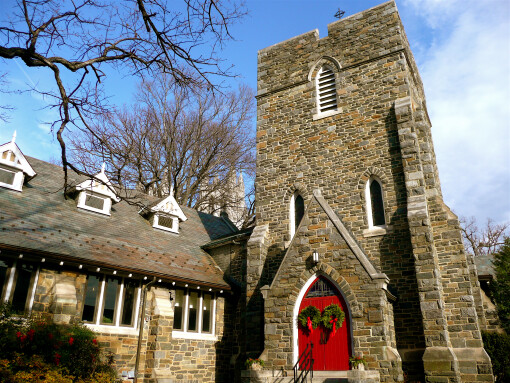The Fifteenth Sunday after Pentecost

Series: Pentecost
Speaker: The Rev'd Jim Quigley
St. Alban’s Parish
The Fifteenth Sunday after Pentecost
Proper 18
September 6, 2015
Mark 7.24-30 (31-37)
© The Rev. James E. Quigley
The Collect of the Day
Grant us, O Lord, to trust in you with all our hearts; for, as you always resist the proud who confide in their own strength, so you never forsake those who make their boast of your mercy; through Jesus Christ our Lord, who lives and reigns with you and the Holy Spirit, one God, now and for ever. Amen.
~Fully God/Fully Human~
From there he set out and went away to the region of Tyre. He entered a house and did not want anyone to know he was there. Yet he could not escape notice, but a woman whose little daughter had an unclean spirit immediately heard about him, and she came and bowed down at his feet. Now the woman was a Gentile, of Syrophoenician origin. She begged him to cast the demon out of her daughter. He said to her, ‘Let the children be fed first, for it is not fair to take the children’s food and throw it to the dogs.’ But she answered him, ‘Sir, even the dogs under the table eat the children’s crumbs.’ Then he said to her, ‘For saying that, you may go—the demon has left your daughter.’ So she went home, found the child lying on the bed, and the demon gone.
Good morning. I begin today by confessing the preacher’s struggle. I’m holding in my heart contrasting images of refugees trying to cross borders and boundaries and seeing their children dead on the beach against the biblical image of a child being healed as a result of prayer and supplication. I’m certain that many or all of the refugees around the world are making fervent requests to the One, Holy and living God. So I’m preaching a sermon that doesn’t avoid the dissonance but attempts to make some sense of one biblical story in the light of our world.
In the name of the Father, the Son and the Holy Spirit, AMEN
Just two years after my ordination to the priesthood I attended a weeklong conference at The College of Preachers called The City of God for American Cities: Reinventing the Urban Church. An Episcopal priest named Douglass Bailey designed the conference and its goal was to inform and inspire the conferees on the visionary process of prophetically proclaiming and living the Word of God in urban centers. We explored how the Word of God is formed in God’s prophets and we went as pilgrims to various places in Washington DC looking for the fingerprints of God on the amazing ministries we would visit, ministries born out of crisis and urgent need. Our pilgrimage included visits to The Church of the Savior, Luther Place Memorial Church and the Children’s Defense Fund. Throughout the week we were blessed to witness a panoply of prophetic wisdom proclaimed by the likes of Gordon Cosby, Parker Palmer, Johnny Ray Youngblood, Jim Singer and Billy Kyles, the last living Memphian that stood with Martin Luther King Jr. on the balcony of the Lorraine Motel when King was assassinated. On one very memorable afternoon we met Marian Wright Edelman on Capitol Hill. Marian was particularly irate because of the Bush administration’s co-opting the heart of one of the Children’s Defense Fund’s slogans, Leave No Child Behind. She also had some issues with U.S. Representative Tom DeLay, and that day’s pilgrimage included Marian leading about 25 of us to the door of DeLay’s office inside the Capitol building. Marian knocked and when the door opened she asked a staffer for a word with DeLay. The staffer said that DeLay was not in the office and unavailable for comment and then, lo and behold, DeLay walked by! I can’t remember who started chanting but we pilgrims, along with Marian, began to shout… DeLay ran away! DeLay ran away!
I’m not trying to confess any political preferences by sharing that story with you and Tom DeLay has certainly never reminded me of Jesus but people like Marian Edelman and the other presenters at the City of God conference do remind me of the woman in today’s gospel reading. The passage describes a Greek woman wresting a blessing from Jesus in the region of Tyre. Jesus went to Tyre, entered a house and didn’t want anyone to know that he was there but couldn’t escape notice. The woman tracks him down and knocks on the door. When the door opens the woman sees Jesus, rushes in, falls to her knees and begs. Jesus tells her he’s unavailable – that he’s got more important work to do. He even insults her. But she doesn’t relent. She hurls her own prophetic word back at him. It works. After being converted by the word Jesus responds: “Amen. For saying that you may go, the demon has left your daughter.”
The passage is remarkable for many reasons. The story represents the only time in the Gospels that Jesus loses an argument. It represents Jesus as being uncharacteristically sympathetic to claims of particularity and privilege when he declares that the Jews are God’s children and as such they should get fed first, and it portrays Jesus in a glaringly negative light as he tells the Syrophoenician woman that compared to his people, hers are just little dogs. Because the Gospels usually represent Jesus as a person who is constant conflict with the religious leaders of Judaism and because earlier in this same chapter Jesus declares the religious establishment in Jerusalem to be hypocritical, this passage is not only remarkable but also baffling.
Despite the interpretive difficulties in this passage the traditional understanding of the latter half of chapter 7 in Mark’s gospel is that Mark, along with the Apostle Paul, honors the trajectory of what theologians would much later describe as salvation-history; that the Good News is proclaimed to the Jews first and only after that to the Gentiles – to those without birthright in the covenant community. Going deeper it’s interesting to note a little history. Josephus writes that the Tyrians were among the Jews’ bitterest enemies and cites pogroms that go back as far as the 1st century B.C.E. We’re pretty sure that Mark was writing his version of the Gospel around the time of the Jewish war of 66-73 C.E and we also know that Tyrian Gentiles killed a considerable number of their Jewish neighbors and put the rest in chains (Joel Marcus). In chapter 21 in The Acts of the Apostles, which was probably written well after Mark, members of the church in Tyre beg Paul not to go to Jerusalem. As scholar Joel Marcus puts it, “theology is always shouting into the wind and in Tyre the wind may be blowing in an anti-Jewish direction; the Christians in Tyre, therefore, may need to hear a clear message about the Jewish “first.”
With that historical-critical explanation for Mark telling this story the way he does – as a warning against hypocrisy to the church in Tyre, we might still wonder, in the context of Mark’s Gospel and given the history between the two groups, why Jesus went to Tyre in the first place. Being a Jew himself, Tyre seems like an odd place for Jesus to hide or seek refuge, doesn’t it? So here’s an unorthodox stab at making some sense of today’s reading.
Keeping in mind that chapter seven in Mark’s Gospel begins with Jesus exposing the hypocrisy of the religious leaders in Jerusalem and knowing how Mark tends to put stories together by playing them off one another we might, or could at least, wonder if Jesus’ journey into Tyre in this Gospel may be as much typology as apology. I’m thinking here of Jonah being sent to Nineveh. Maybe it’s a second temptation in the wilderness. In Mark, as in the other synoptics, after his baptism Jesus is driven (or led) into the wilderness where is tempted, or tested. After passing the tests the tempter leaves. Exegetes of today’s passage in Mark remind us that when Jesus says to the woman, “For saying that you may go” (which can literally be translated as him saying “For giving me that Word”), he is saying, “You have passed the test and therefore the demon has left (you) and your daughter.” Hmm.
Could it be that the Holy Spirit is working in Mark’s telling of the Jesus story so as to reveal to us that Jesus was actually the one being tested? That the Syrophoenician woman acts as a tempter in a yet new wilderness on Jesus’ journey? That Jesus was driven out again – this time to Tyre of all places – so that he could perceive more concretely the necessity that God’s love must break through all boundaries – even his own? And that he passed? He didn’t run away? And by not running away was able to enter more fully into God’s purpose for his life? And could it be that by reading this story, and by embracing and not turning a blind eye to the needs of the world the Holy Spirit is leading us into our own wilderness? A wilderness that exposes the hypocrisies we must overcome, such that we turn, and live?
Amen
 Welcome to St. Alban’s Church! Every Sunday, and most days in between, people gather in this place to worship, to learn, to grow, to share the joys and struggles of our lives, and to seek God’s grace in the midst of our lives. We do not come because we have it all figured out, but because we are seeking light on the way. We come as we are and welcome one another.
Welcome to St. Alban’s Church! Every Sunday, and most days in between, people gather in this place to worship, to learn, to grow, to share the joys and struggles of our lives, and to seek God’s grace in the midst of our lives. We do not come because we have it all figured out, but because we are seeking light on the way. We come as we are and welcome one another.

